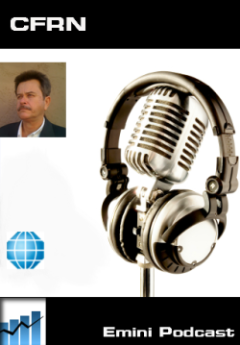Emini Futures Trading Blog
Members' Area
This area does not yet contain any content.
Members Area

Live Market Commentary
Every Trading Day 12-2pm Eastern
To view our charts and participate
in the live discussion
Compatible Trading Platforms
IMPORTANT NOTICE
Trading is risky and not suitable for all people. Please read the CFTC Required Disclosure Page and the CFRN Disclaimer Page as part of our Terms of Service.
Contact Us
DeWayne or Michael
949-423-6464
Copyright © 2005-2019, CFRN. All rights reserved.
Required CFTC Risk Disclosure:
Futures and forex trading contains substantial risk and is not for every investor. An investor
could potentially lose all or more than the initial investment. Risk capital is money that can
be lost without jeopardizing ones’ financial security or lifestyle. Only risk capital should be used for trading and only those with sufficient risk capital should consider trading. Past
performance is not necessarily indicative of future results.
Hypothetical Performance Disclosure:
Hypothetical performance results have many inherent limitations, some of which are
described below. no representation is being made that any account will or is likely to achieve
profits or losses similar to those shown; in fact, there are frequently sharp differences
between hypothetical performance results and the actual results subsequently achieved by
any particular trading program. One of the limitations of hypothetical performance results is
that they are generally prepared with the benefit of hindsight. In addition, hypothetical
trading does not involve financial risk, and no hypothetical trading record can completely
account for the impact of financial risk of actual trading. for example, the ability to
withstand losses or to adhere to a particular trading program in spite of trading losses are
material points which can also adversely affect actual trading results. There are numerous
other factors related to the markets in general or to the implementation of any specific
trading program which cannot be fully accounted for in the preparation of hypothetical
performance results and all which can adversely affect trading results.
Please Note: All performance figures and illustrations on any CFRN Website, Twitter Feed, Facebook Page, Telegram Channel, Webinar, Video, Live Broadcast, Training Room, or elsewhere, were obtained using historical back testing or live real-time data feed on a computer and are not the results of an actual account. No guarantee is inferred that future performance will be like the results shown. Futures trading involves risk. There is a risk of loss in Commodity Futures trading.
U.S. Government Required Disclaimer - Commodity Futures Trading Commission Futures trading has large potential rewards, but also large potential risk. You must be aware of the risks and be willing to accept them in order to invest in the futures markets. Don't trade with money you can't afford to lose. This is neither a solicitation nor an offer to Buy/Sell futures. No representation is being made that any account will or is likely to achieve profits or losses similar to those discussed on this website. The past performance of any trading system or methodology is not necessarily indicative of future results.
Testimonials:
Testimonials appearing on this website may not be representative of other clients or
customers and is not a guarantee of future performance or success.
Disclaimer | CFTC Disclosure - Required Reading For Site Use | Links | Advertising | Emini Trading Computer | Emini Commentary and Analysis | Swing Trading | Christian Financial Radio Network | Russell Emini | Emini Futures Margins
We are the proud founders and patrons of the New hope Orphanage in Uganda.
CFRN
911 W Woodland Ave
Phoenix AZ 85007
Phoenix AZ 85007








NEW YORK/BUCHAREST -- Russell Wasendorf Sr., the founder of failed Iowa brokerage PFGBest, had risky investments a long way from the Midwest markets where he built his name.
More than a decade before he allegedly began hiding more than US$200 million of misappropriated client money in a scheme that unraveled this week, Wasendorf joined three other Chicago traders as founding investors in one of Romania's largest real estate development groups, Avrig 35 Group, which was valued at more than US$1 billion at its height in 2007.
But since 2007 the paper value of his holdings has crashed from around US$150 million to less than US$45 million, as Avrig has written down investments.
As Avrig's complex web of dozens of firms struggles to trade its way out of difficulties, Alexander Hergan, Wasendorf's Romanian-born business partner and a former options trader and founding member of the Chicago Board of Options Exchange (CBOE), hopes the drama in Iowa doesn't upset the firm's recovery.
“I don't want any kind of blemish from Russell's situation to spill into the Avrig Group,” he said in a telephone interview from Romania.
“Avrig 35 was put into insolvency just recently but we've been successful in working our way out of this. We plan to pay down US$50 million of our debts in the next two months. We have saved this company in the past year.”
The firm, well-known in Romania for having built the country's tallest building, adds an unlikely new dimension to the deepening mystery around Wasendorf, whose attempted suicide on Monday set off an FBI investigation, a lawsuit from regulators, and the collapse of PFGBest into bankruptcy.
Avrig's problems after the 2008 global financial crisis also shed new light on Wasendorf's finances, the subject of intense scrutiny as investors seek to trace the missing U.S. funds.
Hergan said he didn't believe Wasendorf's alleged misuse of PFGBest customer funds could be related to Avrig's financial problems.
Asked if he was concerned U.S. regulators may want to look at Avrig as part of their investigation, he said the group would cooperate fully with any investigation.
“Of course we've thought about it, but we're not concerned. They could go after his assets, they could go after his shares in Avrig Group, but the other shareholders will buy them as the value is currently depressed,” Hergan said.
“There is nothing we have to hide.”
Hergan, who immigrated to the United States in 1966 at the age of 19, says he and Mark Proskine — father of current Avrig CEO Matthew Proskine — met Wasendorf in the 1990s, when the Iowa native attempted to buy their trading seats on a Chicago exchange.
While the deal eventually fell through, they maintained contact. Years later, Hergan pitched the idea of investing together in his native Romania, which was entering a period of explosive economic growth a decade after the 1989 collapse of Nicolae Ceauescu's brutal communist regime.
Hergan said that Wasendorf, Hergan, the elder Proskine — and one other Chicago-based investor he declined to name — put up US$500,000 each in 1999 to launch the venture. Hergan moved back to Bucharest the same year.
Avrig rode the boom. The firm was involved in the construction of some of the largest buildings in Romania, including a partnership that built the country's highest skyscraper, the 26-story Bucharest Tower Center, in 2007.
At its peak in 2007, Wasendorf's Romanian investment would likely have dwarfed the value of PFGBest. It was at this time that Wasendorf embarked on his plan to relocate PFGBest from Chicago to his home state of Iowa, designing an US$18 million, 15,000-square-meter custom-built complex in Cedar Springs.
Never Visited
Wasendorf wasn't involved in the day-to-day running of Avrig, Hergan said, and never visited Romania. But the men would talk by telephone, and met in Chicago at least once a year for the group's annual investor meeting.
Avrig expanded to more than 60 companies by 2008, branching into sectors as diverse as television channels, retail stores and asset management. By 2007, UBS bank was advising the company about listing on the London Alternative Investment Market (AIM), and valued the group at more than US$1 billion.
On paper, Wasendorf's initial US$500,000 investment in the group had ballooned. While his stake in the company had been diluted to less than 15 percent as Hergan brought in other investors, it would still have been worth as much as US$150 million, or 300 times the original investment in just eight years.
Plans to list Avrig in London collapsed with the onset of the financial crisis.
“When the hard times hit ... the banks just stopped funding us, some when we were right in the middle of construction,” Hergan said. “The market just stopped functioning.”
By July of last year, the group faced a series of petitions from creditors trying to push Avrig into insolvency due to mounting debts. The Bucharest Tower Center skyscraper had stood empty for at least three years, and Avrig hadn't sold a significant property since the onset of the crisis.
Financial data obtained by Reuters from the Romanian finance ministry showed that Avrig had amassed total debts of about 135 million lei (US$36.6 million) on its balance sheet by 2010. That has more than doubled to around US$80 million now, according to Hergan.
While the company is still operating, its bank account balance was just 13,240 lei (US$3,600) at the end of 2010, the data showed. It had made a loss in each of the past three years.
http://www.chinapost.com.tw/commentary/reuters/2012/07/15/347598/Investment-details.htm